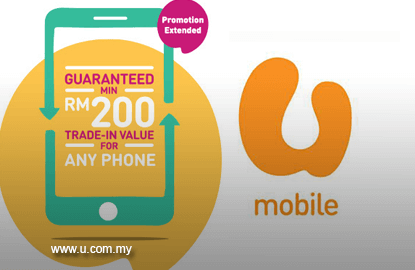
This article first appeared in The Edge Malaysia Weekly, on January 4 - January 10, 2016.
U MOBILE Sdn Bhd’s progress towards an initial public offering (IPO) has been closely followed, particularly by the telecommunications industry.
And amid the interest, be it from potential investors or competitors, the company has been quietly growing its subscriber base, especially in the postpaid segment.
“We have been gaining a lot of postpaid customers. They are coming over through MNP (mobile number portability) from other telcos. We have more port-in than port-out [requests],” CEO Wong Heang Tuck tells The Edge.
However, he declines to reveal the subscriber figures.
For the financial quarter ended Sept 30, 2015 (3QFY2015), Wong says U Mobile’s revenue grew at a double-digit rate.
Data from the Companies Commission of Malaysia shows that U Mobile has been enjoying double-digit revenue growth from FY2012 to FY2014 and net losses have been decreasing significantly.
“I think we are growing very well, considering whatever is happening in the industry. If we look at the combined revenue of the top three, it is stagnant at this stage.”
Between 2012 and 2014, among the Big Three telcos in the country, only DiGi.Com Bhd saw its revenue grow for two consecutive financial years at 5.85% and 4.25%.
Maxis Bhd’s revenue grew 1.3% in FY2013, but fell 7.65% in FY2014.
Similarly, Celcom Axiata Bhd’s revenue rose 3.68% in FY2013, but dropped 3.53% the following year.
In terms of earnings before interest, taxes, depreciation and amortisation (Ebitda), Maxis registered a contraction for two consecutive financial years until FY2014 while DiGi.Com posted 4% growth in FY2013 and FY2014.
Although Celcom saw a 2.07% increase in Ebitda in FY2013, it contracted 11% in FY2014.
Wong concedes that U Mobile is still in the red but he says it is targeting Ebitda break-even in the next two to three years.
“The key thing for us is to focus on customer experience. It is a very wide [subjective] thing, meaning that we have to fix the network quality factor. I think we have done that successfully,” he says.
He notes that in 2014, U Mobile changed its billing system, which resulted in the loss of a quarter of its four million subscribers. “Because of the system migration, we so-called lost over a million subscribers, but our revenue has been growing strongly since then.”
He says U Mobile’s subscriber base has now returned to the four million level. “I think we have been talking about the four million for quite some time, but it is the quality of the four million that matters. Now, at least 80% of our subscribers are revenue-generating. Previously, we were considered lucky if we could touch 50%.”
On U Mobile’s average revenue per user (ARPU), Wong says the postpaid segment is between RM50 and RM80 — below those of the Big Three. However, in the prepaid segment, its ARPU is comparable to theirs.
Save by subscribing to us for your print and/or digital copy.
P/S: The Edge is also available on Apple's AppStore and Androids' Google Play.